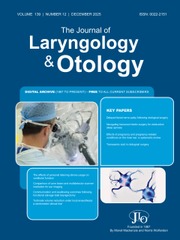No CrossRef data available.
Article contents
The indications, surgical techniques, and complications of transoral robotic surgery in total laryngectomy: a systematic review
Published online by Cambridge University Press: 23 April 2024
Abstract
Transoral robotic surgery total laryngectomy is a promising procedure. We conducted a systematic review to study the indications, surgical techniques and complications of this procedure.
We followed the guidelines outlined in the Preferred Reporting Items for Systematic Reviews and Meta-Analysis statement.
We concluded with 5 studies and 27 surgeries. The main indications of transoral robotic surgery total laryngectomy were selected recurrent laryngeal squamous cell carcinomas, dysfunctional larynx, and specific primary non-squamous cell carcinoma laryngeal cancers. The rate of pharyngocutaneous fistula was 20 per cent overall. In every reported cancer case, the specimen was excised within negative surgical margins. The average time of the procedure was 282.6 minutes.
Transoral robotic surgery total laryngectomy is a safe procedure of high value. The preservation of strap muscles and hyoid bone as well as the sacrifice of less mucosa compared to the traditional technique reduces the risk of certain complications and improves the swallowing outcome.
- Type
- Review Article
- Information
- Copyright
- Copyright © The Author(s), 2024. Published by Cambridge University Press on behalf of J.L.O. (1984) LIMITED
Footnotes
Alexandros Poutoglidis takes responsibility for the integrity of the content of the paper


